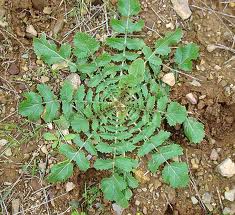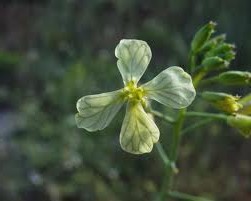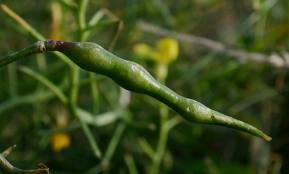I didn’t cut the mustard this morning. I cut the radish… radish greens to be specific, Raphanus raphanistrum, said RA-fa-nus raf-an-ISS-trum.
 The only bad thing about the Wild Radish is it is around for only a few weeks in spring. But I can understand why: A green that delicious would be eaten into extinction if it were available all the time. Well, that might not be accurate. Humans like the deep green tops but it gives livestock tummy aches, and some of them have several tummies to ache. But, I certainly eat more than my fair share.
The only bad thing about the Wild Radish is it is around for only a few weeks in spring. But I can understand why: A green that delicious would be eaten into extinction if it were available all the time. Well, that might not be accurate. Humans like the deep green tops but it gives livestock tummy aches, and some of them have several tummies to ache. But, I certainly eat more than my fair share.
The best place to find Wild Radish greens here in Central Florida is orange groves that till the soil. That is exactly where not only wild radish likes to grow but also its close cousin, the wild mustard. They can be used the same way though mustard can be a little more peppery.
My introduction to mustards happened when I was around 10. My step-father build a house in Maine. To create a lawn he sprinkled hay chaff from the barn on the area of the lawn-to-be. That summer the lawn was 90 percent mustard and 10 percent lambs quarters, Chenopodium album. That mustard grew six feet tall, and ended up on the dinner table.
 Here in Florida one can find both wild radish and wild mustard, now. How do you tell these plants apart once you think you’ve got one or the other? First look at the blossoms. If they are solitary and the four petals have veins, you’ve got a radish. If they are in clumps and they do not have veins, you’ve got a mustard. Also, the radish seed pod is segmented and the mustard seed pod is not. This is probably why the mustard is called the Charlock and the radish the Crooked Charlock. Lastly, the wild radish tends to grow low with a bushy rosette of leaves, its stalk bend over and it rarely gets more than a yard high. Mustards like to grow up and can be up to two yards high, though smaller is common.
Here in Florida one can find both wild radish and wild mustard, now. How do you tell these plants apart once you think you’ve got one or the other? First look at the blossoms. If they are solitary and the four petals have veins, you’ve got a radish. If they are in clumps and they do not have veins, you’ve got a mustard. Also, the radish seed pod is segmented and the mustard seed pod is not. This is probably why the mustard is called the Charlock and the radish the Crooked Charlock. Lastly, the wild radish tends to grow low with a bushy rosette of leaves, its stalk bend over and it rarely gets more than a yard high. Mustards like to grow up and can be up to two yards high, though smaller is common.
 It took me about 20 minutes this morning to collect four pounds of radish wild tops. It used to be an old orange grove that is now being turned into another empty business center. There are no buildings yet and no landscaping. Weed and feed chemicals only go down after inedible grass and toxic ornamentals are planted.
It took me about 20 minutes this morning to collect four pounds of radish wild tops. It used to be an old orange grove that is now being turned into another empty business center. There are no buildings yet and no landscaping. Weed and feed chemicals only go down after inedible grass and toxic ornamentals are planted.
What I will do is blanch these and toss them in the freezer in meal size portions. When I want some I’ll boil them for about 10 minutes. I love them with olive oil, butter, salt, pepper and a dash of balsamic vinegar… In fact… Enough writing… it’s time to to have me a mess of greens.


Love your writing Mr. Jordan. By the way, why do you blanch greens before freezing?
Thanks, yes I do blanch.
Deane, you did not answer “why” do you blanch your greens.
“Why” again?
Blanching the food helps to preserve it by destroying bacteria that causes food to spoil. Also blanching can reduce strong flavors to a palatable level.
I harvest these round where I live on the west coast in Cape Town. It is my secret food garden, as most people don’t know how delicious they are.